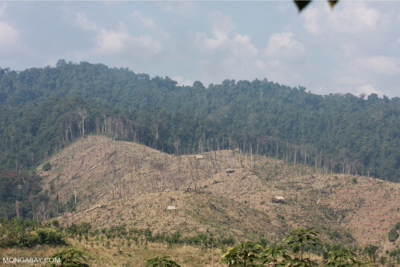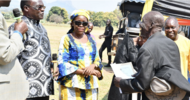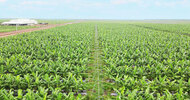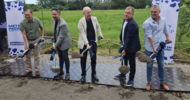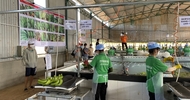Mongabay | 2 April 2024
Land tenure lesson from Laos for forest carbon projects
by Melissa Lo / Simran Kaur / Oluwole Soyinka / Sheng Huan Tang / Song Fu
It’s a hot and humid afternoon in Vientiane, the capital of Laos. Our contact at Burapha Agro-Forestry welcomes us to an empty boardroom full of maps. The meeting goes smoothly, though we can’t help noticing that our contact is the only employee in office.
“Why is it empty?” we wonder. Before we get the answer, we receive the striking news that Burapha Agro-Forestry – one of the first Lao private sector afforestation projects with credits approved through Verra – has gone out of business.
With COP-28 delivering a reality check over the urgent need to halt and reverse forest loss by 2030 to achieve global emissions reduction targets, international attention has been drawn to financing nature-based solutions, such as forest carbon projects, in developing countries. This is especially true in Laos, which has lost approximately 4.37 million hectares of tree cover since 2001. However, forest carbon projects haven’t had a good track record of efficacy; in some cases, projects collapse before fully delivering their intended benefits. Burapha Agro-Forestry is the latest example. So, what’s happening?
Donor-designed forest carbon projects and private sector companies like Burapha Agro-Forestry are facing insurmountable challenges from an age-old problem: land tenure insecurity. And, ultimately, the pursuit of sustainable development in Laos through carbon financing is struggling from a lack of contextual understanding amongst investors on just how tightly interwoven tenure security is with the implementation of forest carbon projects.
Loosely referred to as “forest carbon projects,” these carbon management schemes are nature-based solutions which can be classified under three key categories: (1) Afforestation, Reforestation and Revegetation, (2) Improved Forest Management, and (3) Reducing Emissions from Deforestation and Degradation (REDD). A successful forest carbon project fights climate change by avoiding and reducing emissions through forest conservation and restoration. Often, local communities are financially rewarded for sustainable forest and ecosystem management, thereby preventing further degradation and emissions. Additional revenue can be generated by getting certified carbon credits from the project. The benefits shared also help communities improve local livelihoods.
In Laos, these projects are implemented by development aid agencies, international organizations or private companies. On the ground, these organizations collaborate with local communities, as well as all levels of government to implement their forest carbon projects. Many of these activities are also supported by development banks and other international climate financing instruments.
Challenges rooted in tenure insecurity
The implementation of forest carbon projects relies on a clearly defined and well-regulated land tenure system, as a clear relationship needs to be established between land and carbon ownership to conduct results-based payments. However, such a relationship is difficult to manage in a place like Laos, where land is owned by the state but largely used by local communities through customary tenure arrangements. This translates into a mismatch between operational requirements and reality.
Forest carbon projects rely on consistent land zoning policies to function across a country, but in Laos, incomplete or missing land documentation and overlapping permit grants often leave village borders ambiguous and open to reinterpretation. For projects which acquire land, this involves constant negotiation and renegotiation with nearby villages to ensure appropriate benefit-sharing mechanisms. In some cases, contracts and benefit-sharing mechanisms are completed specific to certain land boundaries that may change after agreements are signed. This means that villages that had previously negotiated a contract may no longer be in the intended beneficiary zone, and new contracts and benefit-sharing mechanisms must be negotiated with new village beneficiaries, costing valuable time and resources.
Forest carbon projects further rely on state authorities to provide support through enforcing forest and land regulations, but Laos is one of the least developed countries in the world and has very limited financial resources for forest management. On the ground, government officials do not receive enough financial and technical assistance to enforce related policies. As a result, officials are unable to protect national parks, and some established forest carbon projects, from illegal land use.
Finally, there is the risk of unequal benefit distribution from forest carbon projects amongst key actors. Some projects do not directly engage with local communities at the individual level, and so entrust the sharing of benefits to a village committee. However, marginalized groups who cannot prove their customary land tenure may be excluded from the decision-making processes and thus are unable to be justly compensated. The situation is further compounded by gendered power dynamics of executive decision-making, where women representatives are sidelined during village committee meetings.
While Burapha Agro-Forestry engaged in extensive free, prior and informed consent (FPIC) processes and followed international standards for responsible carbon investment, zoning challenges and limited state capacity still undermined their ability to secure a contiguous piece of land. In some cases, local officials were unable to help settle land disputes, hindering the company’s access to land, even to areas already granted through concession agreements. Ultimately, they failed to establish a profitable base of operations where logistics and value-added processing facilities could be efficiently linked.
Despite making some revenue through transacting carbon credits, the company’s financial situation was nonetheless exacerbated by its underperforming plywood business (made of eucalyptus trees grown on their plantations) and continued difficulties in attracting investors. By the end of 2023, Burapha Agro-Forestry was no longer able to sustain its business.
Lesson from Laos
Despite the challenges, there is still hope in the principle of forest carbon projects for preserving forests and securing land tenure. There is also increased international demand for high-integrity projects. But before committing to a forest carbon project in Laos, donor communities and the private sector should proceed with caution. Forest carbon projects must incorporate ex-ante and ongoing measures, such as participatory land use planning, to address land tenure insecurity challenges.
In the meantime, forest carbon projects should continuously engage in capacity-building for local communities and authorities, thus creating an enabling environment for just benefit-sharing, securing land tenure, and the sustainability of these projects to reduce emissions over the long term. For eager private sector actors wishing to invest in carbon offset in Laos, exercising due diligence over the potential financial and operational impacts of tenure insecurity, as well as completing a thorough market entry analysis with stakeholder engagement, are musts.
While Burapha Agro-Forestry may have run its course, other organizations have a shot to learn from its downfall and enable their projects to succeed.
Melissa Lo, Simran Kaur, Oluwole Soyinka, Sheng Huan Tang and Song Fu are Masters of Public Policy and Global Affairs students from the University of British Columbia, working in collaboration with Mekong Region Land Governance.


